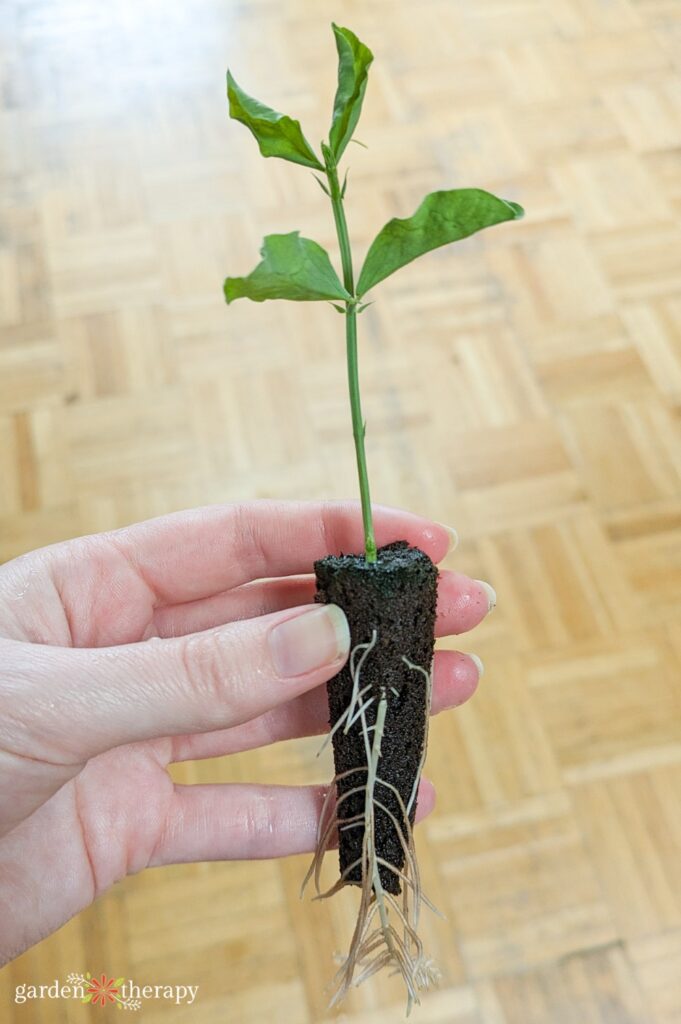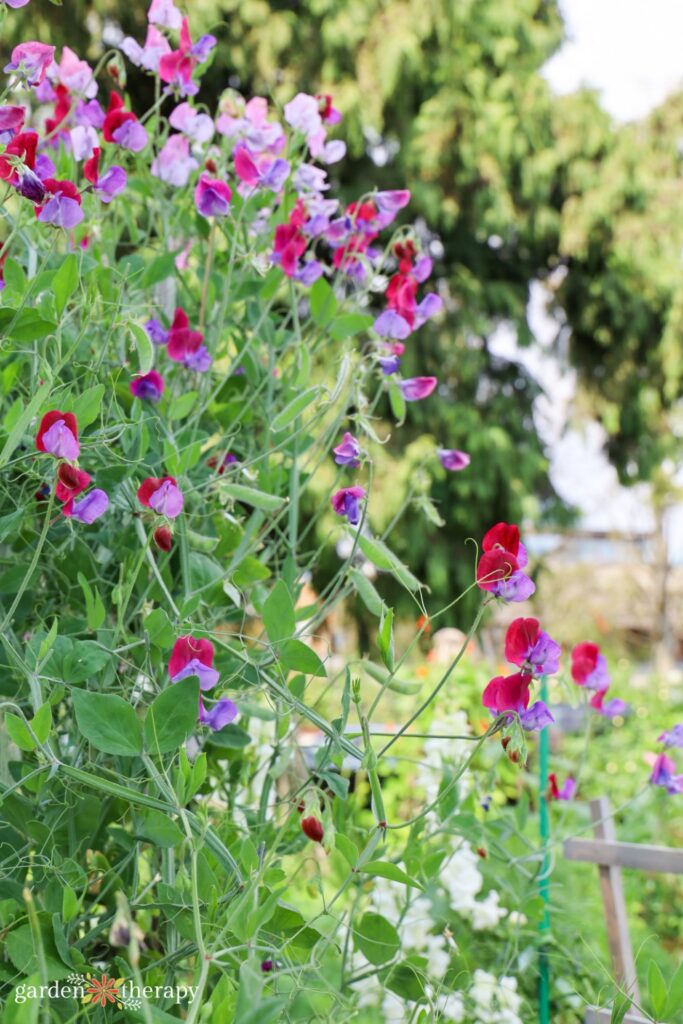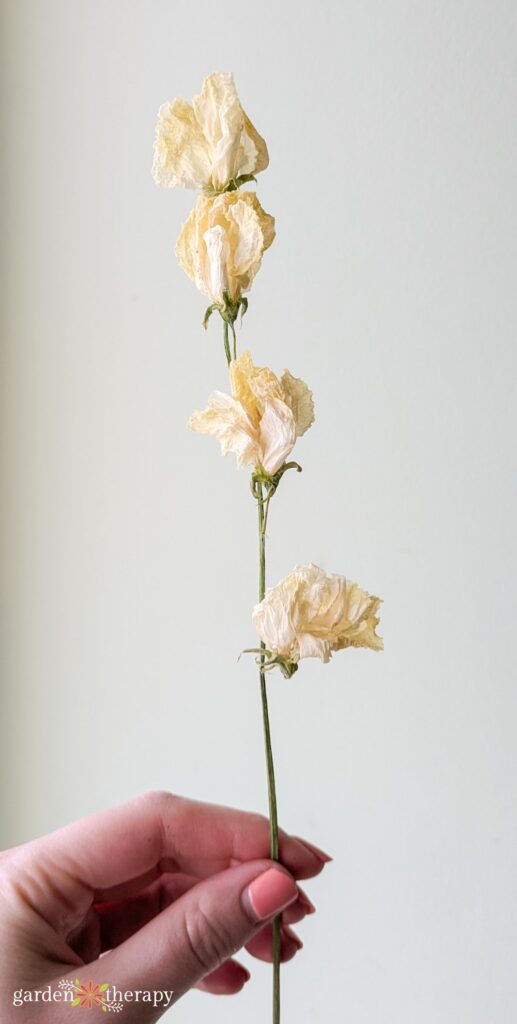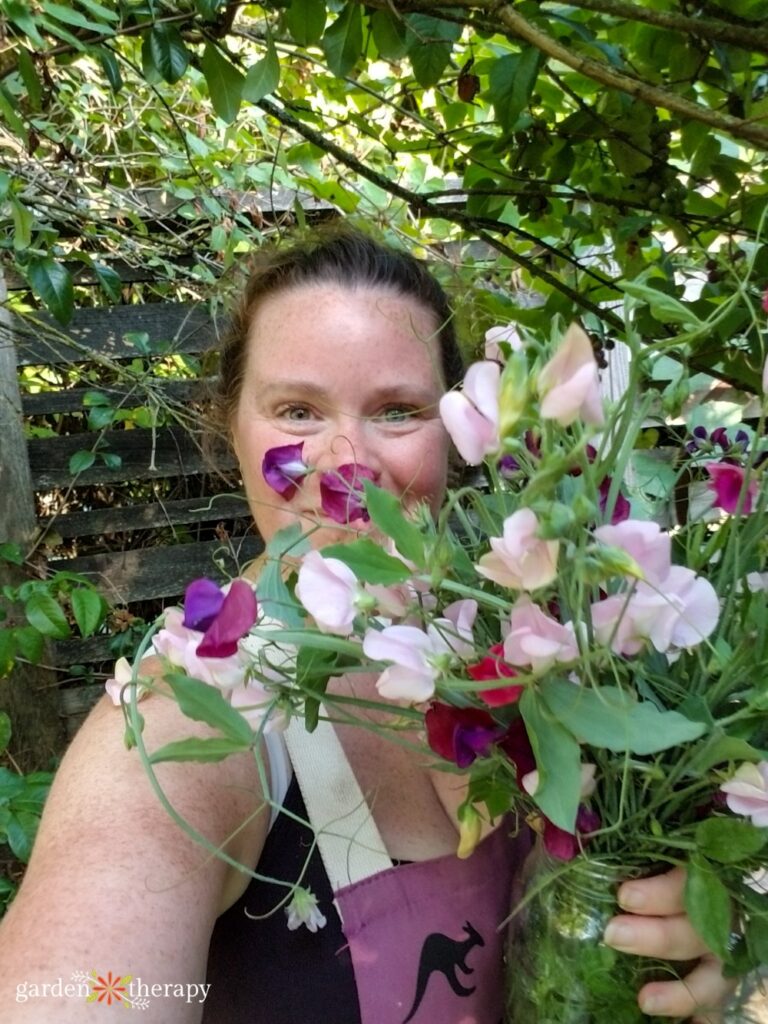A long-time flower staple, sweet peas add plenty of whimsy and a delicious fragrance to every garden they’re grown in. Only recently have they become a favourite for bouquets and arrangements. Here are a few tricks worth knowing if you plan on adding a sweet pea plant to your cutting garden!

Sweet peas were a staple in the garden when I was a child. When deciding what to grow, sweet peas were always sown along the fence. My mother loves them for their signature scent—and she’s not alone in that.
Sweet peas have long reigned in the garden, being very popular in English and cottage gardens. Thanks to their fragrance, colour, and curly tendrils, they have a whimsical appearance when left to their own devices.
What was once an old-fashioned flower is now gaining popularity in the flower farming and florist space. It’s the latest “vintage” flower people can’t get enough of.
I started growing sweet peas in my own garden a couple of years ago, and I was quickly hooked. They can be a bit finicky to start, but once you know what they like, they’re not hard to grow.
So, if you want to add sweet peas to your cutting garden, here’s what you need to know!

Types of Sweet Pea Plants
Thanks to centuries of cultivation, there are many different cultivars of sweet peas (Lathyrus odoratus). You can find sweet peas in nearly every colour, most bursting with their signature sweet scent.
There are three main types of sweet peas, and which you should grow depends on where you live.
Winter flowering. These sweet peas are ideal for those in warm climates, like the southern states or Australia. They’re best planted in autumn and will flower mid-winter—though they still need protection from frost if that is a risk in the area.
Spring flowering. These are mid-season bloomers. They bloom a few weeks after the winter flowering and are most often grown in warmer climates or with protection.
Summer flowering. These are the most popular types of sweet peas since they’re the easiest to care for. They’re the most tolerant of heat since they start later in the season. That being said, they’re not good for hot climates but are best for those who experience cold winters. The Spencer varieties are summer flowering.
When to Start Sweet Pea Seeds
Mild climates can grow their sweet peas in the fall since it gives you a month’s head start on sweet pea growth and will result in very bushy sweet pea plants. These should be started in containers and given some protection from frost, such as an unheated greenhouse or cold frame.
Everywhere else should sow their sweet peas in late winter or early spring. Sweet peas LOVE cold conditions and need them to grow—too much heat is one of the main reasons sweet pea plants fail.
If direct sowing, you should start them about the time of the last frost. If starting indoors, you can do so as early as 8-10 weeks before the last frost, depending on whether or not you can provide protection for them when it’s time to transplant. I’ll get into this more in the next section!
Keep these temperatures in mind:
- Germination: 10-13°C (50-55°F)
- Flowering temperature: 7-21°C (44-70°F)
- Good average: 18°C days and 7°C nights (64°F and 44°F)

Starting Sweet Peas Indoors
Before you start the sweet peas, soak the seeds in a cup of water for 24 hours. Sweet pea seeds have a tough coat, which will help soften them. Some people skip this step, but I find it doesn’t hurt to do so.
Sweet peas are known for vigorous root growth, so they need a taller starting pot than the average seedling. Make sure the container is at least 4 inches deep.
Sweet pea seeds require darkness to sprout, so place them ½ inch deep into the soil. Water the seeds from the top (as opposed to bottom watering) since sweet peas don’t like too much moisture. Don’t use a heat mat for sweet peas.
You want to start sweet peas indoors about three weeks before you move them outside. Sweet peas can be transplanted when they are 3-5 inches tall.
If you have some kind of frost protection for your plants, you can move them outside very early. If not protected, you can wait until two to three weeks before the last frost to transplant them outside.
Since they like the cold, sweet peas can handle frosts and low temperatures. That being said, too much frost and low temps will stress out the plant, which is never good.

Growing Sweet Peas Plants
You can also direct sow sweet peas. I’ve had my challenges with direct sowing sweet peas, primarily because it rains so much here in Vancouver that the soil is just too moist and the seeds rot. Starting them indoors allows me to control the conditions more favourably. Direct sow around the time of your last frost date.
When planting sweet peas out in the garden, make sure to add a layer of compost. Sweet peas are heavy feeders and will benefit from the nutrient boost. Also, consider adding compost tea throughout the season.
Sweet peas can benefit from pest protection when they’re young. For me, I struggle with the neighbourhood rat eating my young seedlings in the spring, so I keep my sweet peas under some frost cloth held in place with landscaping pins to keep them safe from munching.
Sweet peas require full sun, anywhere from 8 to 12 hours a day. Avoid planting them in an area where it is too moist, as the roots don’t like to be soggy.

Making a Sweet Pea Trellis
The biggest component to taking care of sweet peas is ensuring they have the right vertical support. Sweet peas will require either support netting or a trellis to grow. A vining plant, their tendrils will curl around and climb upwards.
Add in your vertical support before planting. T-posts with a tight trellis netting work great, as does chicken wire.
If you plan on cutting sweet peas and using them in arrangements, you have to put in work to encourage straight stems. Every week, you need to secure the new stems with twine, tying them in the direction you want. Sweet peas grow quite fast, so it’s important to keep up with this. I secure mine about once a week.

Pinching Sweet Peas
If you live in a warm climate where you can grow fall-sown sweet peas, you don’t need to worry about pinching—they will naturally branch on their own.
For all winter and spring-sown sweet peas, I recommend pinching the plants before you plant them outside. Pinch the central growth, leaving behind only 2-3 leaf nodes. This will encourage the plant to become bushy and at least double the number of stems and flowers your plant produces.
I know just how difficult pinching can be—you don’t want to remove growth from your precious baby plant! But trust me, it will recover just fine, and you’ll have more blooms to show for it.
If you’re feeling extra savvy, you can use those stems that you have pinched off and root them in a cup of water. In a couple of weeks, they should have enough roots that you can then pot them up and get a bonus sweet pea plant.

Harvesting Sweet Peas for Vase Arrangements
Sweet peas have a short vase life compared to other flowers, just 4-5 days. To harvest, cut the stems in the early morning when the plant is the most hydrated. Choose stems that have two or more unopened flowers at the tip.
If you have long stems, you can harvest each individually. If you have shorter stems, you can harvest entire sections of the vine with several stems on them.
Sweet peas benefit from using a flower preservative, so be sure to add those to any harvesting buckets as well as arrangements.
The flowers won’t continue to open after flowering. If you choose to pick a stem where all the flowers are open, just know that it will have a shorter vase life.
If you don’t intend to cut the stems for arrangements, deadhead spent flower blooms to encourage more growth.

FAQ About Growing Sweet Peas
Sweet pea plants will become leggy if they’re not getting enough sunlight or if the temperature is too warm. You ideally want short and stalky sweet pea seedlings. Since they grow quickly, they can bolt and become leggy overnight if they have improper conditions.
Depending on what type of sweet pea you have and the climate, your sweet pea may bloom in winter through to late spring. You can expect sweet peas to mature in 75-90 days.
Winter flowering sweet peas will bloom in mid-to-late winter, while summer flowering sweet peas bloom in late spring and can keep blooming all the way to the fall in cool climates.
Most sweet peas used for cutting purposes are summer flowering sweet peas, including the Spencer cultivars, which are known for having long stems.
Some great sweet peas with long stems include Spring Sunshine Peach, Bix, the Winter Sunshine series, Restormel, and Charlie’s Angel.

Sweet Pea Resources
Sweet pea seeds can be hard to come by, especially as they rise in popularity. Here are some of the best resources for finding sweet pea seeds in North America:
For those who want to dive really deep into sweet peas, check out these sweet pea books by growers who’ve dedicated their gardens to growing sweet peas:

More Cutting Flowers to Grow
From Vancouver, BC, Holly is Garden Therapy’s Content Manager. She has a BFA in Writing from the University of Victoria as well as a diploma in Floristry Design from Burnaby CCE. At home, she loves to grow cut flowers and dried flowers for her business, Dirty Daisy Florals, and is an avid houseplant collector and lover of bees. You can find her at @dirtydaisyflorals and @hollyheuversocial.





